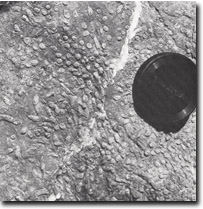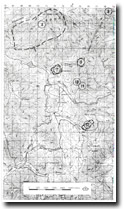8423-12 Bonanza Gully
|
This information has been developed from the publications:
|
Location: | 754904. 4 kilometres south-east of Bindi. |  Bonanza Gully, Syringopera flaccida. |
Abstract: | Exposures of Buchan Caves Limestone. | |
Access: | Saw Pit Creek Track. | |
Ownership: | Private land. | |
Geology: | Excellent exposures of Buchan Caves Limestone occur along Bonanza Gully. The limestone at this locality is near the top of the sequence. It is interbedded with siltstones, and contains a rich shelly and coral fauna, and is stratigraphically higher than the highest beds of this formation at Buchan. The fauna indicate that this horizon corresponds generally with that occurring at approximately the middle of the Pyramids Member in the Buchan area. | |
Geomorphology: | Of interest is the fact that although the Bindi area contains a relatively large limestone deposit, surface karst features are poorly developed. A number of caves are recorded and the numerous springs suggest a more extensive cave system exists. | |
Significance: | Regional. The extraordinarily rich fossil fauna, together with the stratigraphic position of these limestone deposits, are of particular interest geologically. | |
Management: | Management strategies must take into account the abundant and diverse fossil fauna and conservation of, and the responsible collection from the outcrops is desirable. The management principles for Karst regions outlined apply in this area. | |
References: | Matthews, P.G. (ed) 1968. Speleological Handbook. Victorian Speleological Association. McAndrew, J. and Marsden, M.A.H. (eds) 1973. Regional Guide to Victorian Geology. Second Edition, School of Geology, University of Melbourne. | |

Site 8423-6 to 8423-12


